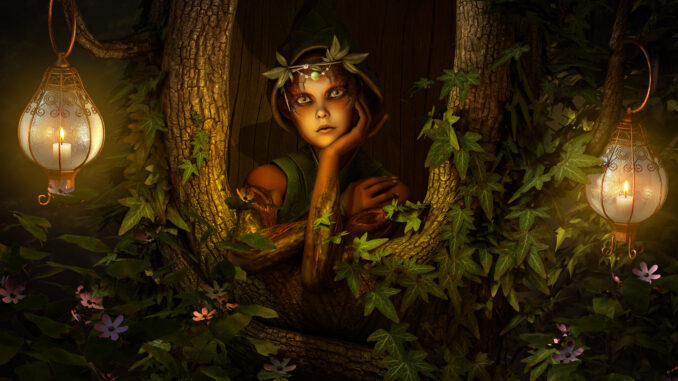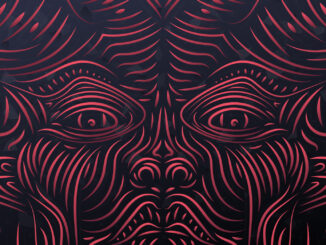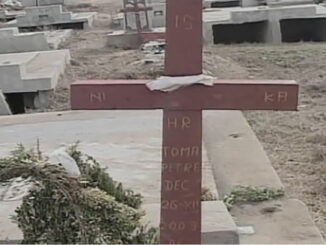
When I was little boy, my grandfather told my cousins and I a story from his own childhood. One day as he was fishing at a local pond, he became intensely aware of being watched. He scanned the area looking for the unseen intruder. Not seeing anyone he was about to go back to his fishing when he saw a streak of green dart behind a tree and heard a strange laugh. Thinking one of his cousins was playing a trick he set his fishing rod down and approached the tree where he was sure someone was hiding.
When he rounded the tree, the person he came upon was anything but a prank playing family member. Leaning against the tree was a short, bearded man smoking a pipe and wearing green clothing. Coming from an Irish family, he knew immediately what he was seeing – a being that is said to live only in legend, a leprechaun.
My grandfather approached the little man trying to speak to him. The leprechaun merely stared off into the woods. Then my grandfather, knowing what he would gain if he caught the little man, tried to grab him. My grandpa was shocked when the leprechaun vanished into thin air. He was even more surprised when his clothes vanished, leaving him standing there in the nude.
As he approached his home, he saw his mother waiting for him at the doorstep. When he reached the door his mother said in a thick Irish brogue, “William Mulligan Vice, how many times have I told ye not to bother with the wee folk?”
To his dying day my grandfather maintained that his tale was true. Upon reading this, a person might think this took place somewhere in Ireland. Not hardly, it took place near his childhood home outside of Cincinnati, Ohio, about as far away as you could get from Ireland.
Folklorists firmly believe that when Europeans came to our country in the mass immigrations of the 19th and early 20th centuries, they brought with them their customs as well as their legends and lore of fae folk and other little people. While this may be true, Native American legends are filled with folk tales of little people that sound oddly like the little people of Celtic and Germanic legends.
But before we get to that, more on the American leprechaun.

T-Shirts, Mugs and More!
We now have t-shirts, tarot decks, ESP cards, coffee mugs, face masks, and much more merchandise available for purchase. Every dollar spent helps fund Paranormal Study!
A few years ago in a primarily African American neighborhood of Mobile, Alabama, residents were reporting a strange little creature that sounded much like the leprechaun from my grandfather’s tale.
Residents reported to local news shows that a rowdy little man with a beard and green clothing was living in a tree. When the news teams arrived, the only thing they found were dozens of people crowding the street hoping to see the leprechaun and maybe get their hands on his gold.
Many theories were offered to explain what locals were witnessing. Some believed a delusional drug addict was living in the tree. While others believed it was nothing more than shadows playing tricks on peoples’ eyes. This certainly was was not an Irish American neighborhood, but people firmly believed they were seeing a strange little man in the tree. If this can’t be attributed to Irish folklore, then maybe people were seeing something magical and wholly local.
As I mentioned, Native American folklore is rich with legends of little people. Little people who lived among the local tribes, but were hidden away in the vast forests that once filled the North American continent. One such race of little people lived in the forests of the American North East and figured heavily into the folklore of the Wampanoag tribe.
The Pukwudgie are a race of little people that are believed to live in the region of what is known today as Cape Cod. The Pukwudgie were said to look very similar to humans, except they were 2-3 feet tall, and have a large bulbous nose, and also elongated fingers and ears.
The Wampanoag people believed the Pukwudgie were created by Maushop, a giant god that created the world. At first the Pukwudgie and humans lived side by side in relative peace. One day that peace was broken and the Pukwudgie were forced to flee into the forests. Pukwudgie are said to be malicious and will use magic and poison arrows to kill humans. We must avoid the Pukwedgie at all costs.
Going a little further southwest, another folktale of little people can be found. Although they are very similar in appearance to the Pukwudgie of the Wampanoag, the Cherokee Little People have a much different, and decidedly friendlier disposition.
The Little People of Cherokee legend are said to live in the mountains and forests of Tennessee. At night, the Cherokee claim to hear singing and drumming coming from the mountains. The Little People are said to be friendly, even helpful to their human neighbors. But if their nighttime revelries are disturbed, the Little People will disappear into the valleys never to help mankind again.
The Hawaiian islands are a relative newcomer to the United States. Granted statehood in 1959, Hawaiian people bring a culture rich in tradition to the union. They also bring a rich folklore of angry volcano goddesses and stories of little people known as the Menehune.
According to Hawaiian folklore, the Menehune were the original inhabitants of the islands before the Polynesian people arrived on their shore. The Menehune are said to live in the many hidden valleys of Hawaii. The Menehune were great craftsmen who created temples, homes, and roads some that are said to still exist today. Generally, the Menehune avoid contact with humans and locals know to avoid the Menehune. However, there are a few recorded stories of Menehune, playing mean spirited tricks on road workers that were threatening Menehune land. Tools vanished, workers were mysteriously injured, and heavy equipment refused to work. It wasn’t uncommon for workers to halt construction until a Kahuna, a Hawaiian shaman, was brought in to appease the little people.
When I consider these tales, I find merit in my grandfather’s story. Do these magical beings really exist? That I do not know. Do I believe my grandfather? Yes, I do.
If you found the content in this article to be of any value to your paranormal studies, please let us know in the comments below. Feel free to share this article with your friends as well because if you found it interesting, they might too.
Do You Want To Know More?
Our content creators also have podcasts that go much deeper into paranormal topics.
Tim Woolworth’s Walk in the Shadows, an episodic masterclass that consists of a deep dive into all things Fortean, paranormal and supernatural.
Rick Hale teams up with Stephen Lancaster in The Shadow Initiative where they explore various paranormal topics and discuss current paranormal news.
Please check these shows out and visit Paranormal Study social media to keep up to date on articles and all the things our authors are doing.




Be the first to comment